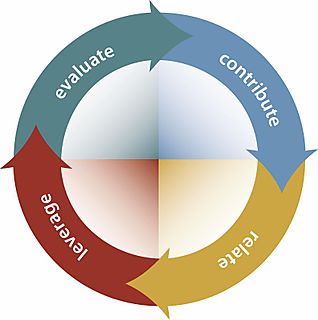Google is now a transitive verb according to the dictionary. As is commented by every generation, the world is different than it used to be.
Roadmap Print Collateral (Print on 11×17 and fold left 1/8 with map to meet right 3/8)
Though the way people use the internet might have evolved, the internet has not created any new human behavior. Networking has grown into a constant and widespread activity, but it is still networking. Word of mouth has transformed into an overnight fortune maker by becoming viral marketing, but it is still word of mouth. What this evolution has created is a wealth of opportunity for the right ideas to rise to the top, through effective use of social media.
And so I, like many bloggers before me, choose to share my thoughts on how to deal with this ever changing landscape. The following entry is a rather theoretical roadmap for marketing (B2B, B2C, marketing your personal brand, whatever.) So, if you are looking for a tactical plan to use out of the box, I’m afraid my only advice is to stop looking, because every brand’s social media plan should be rather unique. The simple nature of social media is that it is fast to evolve and your brand will resonate differently in each new venue social media offers. What you might find in the following article is some of the information I have either learned or come across in my venture to learn more about social media marketing.
Also be forewarned that this post is rather long (but I do have a very small puppy chewing on my toes as I write this, so I am motivated to get to the point and get off the computer.)
Social Media Roadmap Presentation Slides
What is Social Media
Let’s just use some social media to define itself (users of social media love to write about social media it seems… yeah yeah, I know.)
In the words of Wikipedia:
Social media can take many different forms, including Internet forums, message boards, weblogs, wikis, podcasts, pictures and video. Technologies include: blogs, picture-sharing, vlogs, wall-postings, email, instant messaging, music-sharing, crowdsourcing, and voice over IP, to name a few.
Examples of social media applications are Google Groups (reference, social networking), Wikipedia (reference), MySpace (social networking), Facebook (social networking), Last.fm (personal music), YouTube (social networking and video sharing), Second Life (virtual reality), Flickr (photo sharing), Twitter (social networking and microblogging) and other microblogs such as Jaiku and Pownce. Many of these social media services can be integrated via social network aggregation platforms like Mybloglog and Plaxo. (http://en.wikipedia.org/wiki/Social_media 20 June 2008)<\p>
Who is Participating?
People no longer connect to the internet, they are either connected or not. This has created a new place in our lives for media. There is a smooth transition between the real and virtual when it comes to information for those connected, and writing a review on Yelp is just as likely to be my first action after trying a new restaurant as telling my friends about it.
Certainly there are a few differences in usage out there. Different parts of the world have different numbers of people connected to the web at all:
|
There is Opportunity Everywhere
|
|
|
|
|
|
|
|
|
Population
|
Internet Usage,
|
% Population
|
Usage Growth
|
|
|
( 2008 Est.)
|
Latest Data
|
( Penetration )
|
2000-2008
|
|
Africa
|
955,206,348
|
51,022,400
|
5.30%
|
1030.20%
|
|
Asia
|
3,776,181,949
|
529,701,704
|
14.00%
|
363.40%
|
|
Europe
|
800,401,065
|
382,005,271
|
47.70%
|
263.50%
|
|
Middle East
|
197,090,443
|
41,939,200
|
21.30%
|
1176.80%
|
|
North America
|
337,167,248
|
246,402,574
|
73.10%
|
127.90%
|
|
Latin America/Caribbean
|
576,091,673
|
137,300,309
|
23.80%
|
659.90%
|
|
Oceania / Australia
|
33,981,562
|
19,353,462
|
57.00%
|
154.00%
|
|
Global Totals
|
6,676,120,288
|
1,407,724,920
|
21.10%
|
290.00%
|
|
NOTES: (1) Internet Usage and World Population Statistics are for March 31, 2008. (2) Demographic (Population) numbers are based on data from the US Census Bureau . (3) Internet usage information comes from data published by Nielsen//NetRatings, by the International Telecommunications Union, by local NIC, and other reliable sources. (4) This information was gathered at http://www.internetworldstats.com. Copyright © 2001 – 2008, Miniwatts Marketing Group. All rights reserved worldwide.
|
And of course, younger users participate more than older users and smaller businesses adopted social media before big businesses, but the key is to find what your audience is doing. As a B2B marketer in high tech, I was surprised and pleased to find that 90% of B2B professionals with technology buying decision power consume or create internet videos, 80% participate in blogs, 80% participate in wikis, almost 70% participate in social networking sites, and more than 50% consume podcasts. I was lucky enough that KnowledgeStorm assembled this neatly targeted information about my audience, perhaps you will be just as lucky.
The Social Media Marketing Process
Social media is an ever changing landscape and communities continue to evolve (sometimes devolve) and adapt to new circumstances and opportunities. Changes to accessibility, such as cheaper mobile data packages and expanding free WiFi, are making video and microblogging newly viable, and communities are already moving to take advantage of them.
Because of constant change, staying relevant in social media means an adaptive approach, which is why I have put together a cyclical process.

Social Media Marketing Process
Stage 1 – Evaluate the Landscape
Monitor
The place to start, whether you are uninitiated to social media or a strong participant looking to effectively market through it, is with evaluation. Your first tools for this phase will be sites such as Google Blog Search, Technorati, Summarize, and other blog aggregators to find the existing conversations. Also useful is TweetScan for Twitter and PlurkLurker for Plurk.
Start by identifying relevant topics. These might include conversations specifically about your brand, conversations about your industry, or tangential conversations that might impact your industry if appropriately applied.
You want to know if your brand is being discussed, because this could offer you access to existing web momentum. Negative coverage offers you an opportunity to be proactive (and impress your disgruntled stakeholders with successful solutions) and positive coverage is something you can leverage right away.
Identifying conversations relevant to your industry are useful as they can help you set expectations. You may be able to generate additional interest in your industry once you have built some influence, but it will be easiest to participate in the conversations already happening when just starting out in social media.
Next, identify influential users. Find out who people are listening to, and join their conversations. Here you will stay tapped into the greater community, and possibly build relationships that can help you develop a more relevant online presence for yourself. These are also useful figures to be aware of when pursuing social media relations.
Finally, identify the influential channels for your industry or specialty. This will be useful in choosing your own marketing mix and may provide you insight into the community. Backchannels are especially useful to uncover, as you can gain valuable insight into the particular idiosyncrasies of your industry’s social environment. A good example of such a useful backchannel is http://angryjournalist.com/ , where communications professionals can learn what journalists most dislike about them. Back channels may go beyond open communities to include groups on social networking sites or email lists that are sometimes more challenging to discover.
, where communications professionals can learn what journalists most dislike about them. Back channels may go beyond open communities to include groups on social networking sites or email lists that are sometimes more challenging to discover.
There will be a great deal of qualitative measurement in this phase. Some metrics may be available (such as readers and subscribers to certain blogs or members of certain communities), but you may need to develop your own opinions about channels based on mentions by others and presence in respectable newsletters or already identified influential channels.
Strategize
Set specific goals for what you are trying to do in your social media endeavor. Some common goals for social media might be:
1. Engage the community
a. Increased brand loyalty (brand evangelists)
b. WOM & Viral Marketing
2. Communication
a. Voice of the customer
b. Pulse of stakeholders
3. Transparency and Visibility
a. Viral marketing
b. Develop brand personality
4. Collaboration
a. Product development
b. Creative development
Then establish realistic expectations of how you might realize your goals. New ideas, brand exposure, valuable conversations, and the development of an influential voice might be realistic expectations, but building throngs of followers that will do whatever you say might be a bit beyond your future with social media. You should also clearly delineate whether you are pursuing social media or SEO, because there are tempting link-baiting opportunities that you can pursue through social media, but relating to the linkerati is quite different than relating to your target audience. I would suggest keeping those activities separate, and personally, I see content as a more useful internet currency than links. You will have to decide for yourself.
Also be aware of the challenges you might face. Fear is absolutely the top reason for social media strategies that fail before they begin. The lack of control inherent in engaging with your audience rather than broadcasting to them is something that many professionals are not prepared to accept. Also top on the fear list are fears of criticism and fears of privacy loss. The only one that I think is not viable is the fear of criticism. If you are not prepared to do anything about criticism, then perhaps it is best that you not know; but it is a far better business practice to know what people are thinking of your brand, whether it is good or bad. Fear of privacy loss is something you can manage and mitigate through well defined guidelines regarding content creation (more on this later.)
Another challenge facing any business is availability of resources and prioritization. There is a minimum investment of time required to succeed in this medium, and you need to strike a balance between your existing business goals and your commitment to social media. Most successful strategies will involve your organization’s experts and it may fall to marketing to convince them of the value in participating with social media.
Codify Your Tactics
Develop a set of well defined guidelines based on your expectations and challenges, before you embark on this endeavor. Define boundaries for participants such as excluding internal politics and not disclosing protected information. Establish best practices for contributors such as providing links in comments that direct readers back to your core messaging platform (website or social media.) Provide direction for how to effect a conversational tone and what to do with useful information your team members might come across in their social media explorations. Strong guidelines are important, because you will be expanding the number of people involved in your marketing efforts, but want to still maintain brand cohesion.
Social Media Metrics
Social media can be measured through a mixture of media coverage metrics, web traffic metrics, and newly relevant social media metrics. To start, measure:
- Positive / Negative coverage or comments
- RSS subscriptions
- Bookmarks
- Presence on existing platforms (Facebook fans, bookmarking site presence, incoming links.)
- Amplification of messages (blog posts, referrals, wiki entries)
- Views and unique visitors
Stage 2 – Build a Relevant Presence
Participate. There is not much more to say for this phase. To succeed in social media marketing, it is best to be a member of the community rather than an outsider trying to talk into the community. It is extraordinarily transparent when an organization’s representative inserts themselves into a forum or community for specific motives.
Share your expertise as a member of the community, and you will find a voice that can more realistically and effectively interact with other members of the community. The basic rules of participation are as follows:
- Establish profiles on relevant sites
- Comment in conversations
- Comment on blogs
- Comment on anything you can comment on
- Share media, knowledge, interesting thoughts
- Reach out and build relationship with other users
Once you become a successful participant you will be ready to begin developing your own community. Do not progress to stage three until you are a successful participant, because you will undoubtedly gain an important sociological education by learning how social media works before trying to carve out your corner of it.
Stage 3 – Develop Your Community
Decide on your marketing mix and begin building your social media mesh. As a participant you will already have profiles and presence to link back to the platforms you choose.
Each platform has its own benefits and limitations, and you should choose them based on the merits they hold in the current climate. Everyone is familiar with blogs, but not everyone should attempt hosting a blog.
Search the web and find all you need to know about how to develop a good private online community, a good blog, a good forum, a good podcast, a good video presentation, and more and more. Of course, you will have to discern between content you agree with and content you do not (some say this blog post is far far too long and others say you should have some pillar articles that are this in depth… you need to decide some things for yourself.)
Draw Participants
Whether social media users or not, your existing stakeholders are a great place to start recruiting participants. Use your existing communications infrastructure to promote your social media presence. Place links on your website, in your newsletter and in your email signatures. Distribute URL’s at tradeshows and brick and mortar locations. You should also consider including social media information on your business cards, whether user specific or company wide. And, of course, you can always advertise your social media presence drawing certain search strings or certain audiences from other venues.
Integrate Social Media with Other Efforts
Develop a social media relations strategy to complement your standard media relations strategy. Consider how you will treat bloggers as compared to classic media journalists (developing social media releases and deciding whether to make information available simultaneously or to specific audiences first.)
With a social media relations effort in place, decide how to treat social media coverage. Developing a social media newsroom might let you publish important topics from your community’s conversations and display public customer feedback as well as displaying coverage. Infusing your existing newsfeed with social media coverage might lend relevance to social media coverage in the eyes of initiated and uninitiated readers alike.
Stage 4 – Leverage Your Presence
Once you have accomplished your goals, you will hopefully have some momentum built up, allowing much of the community to hum along without you. At this stage, the more control you give your stakeholders, the more they will do for you. Your role is to monitor, motivate (when necessary), and sparingly publicize newsworthy items that the community might actually be interested in.
Use your social media presence to poll your constituency and harvest new ideas. Take advantage of the strong avenues of communication you have worked to build and monitor as much as you participate.
Build a strong focus on measurement and prepare to start the cycle over again. You may find that the mix you have chosen is not as effective as another combination, and you will be able to transition truly invested users from one venue to another if you do it gradually.
Make sure you know what is going on in your community. You now have the opportunity to have a self-sustaining engine of creative looks into the future, very relevant reviews of the past and present, as well as an emotional measure of your brand’s perception in the community.
Repeat
This is an evolving landscape. Things will change and you want to make this process constant. Focus on adaptability and constant improvement when pursuing social media marketing.
Some Links You Might Find Useful or Interesting
Lessons and instructions for social media marketing (blog now considered complete): http://nowisgone.com/
Glossary of social media terms: http://www.converstations.com/blogging_glossary.html
What U.S. internet users are doing with social media: http://www.businessweek.com/magazine/content/07_24/b4038405.htm







